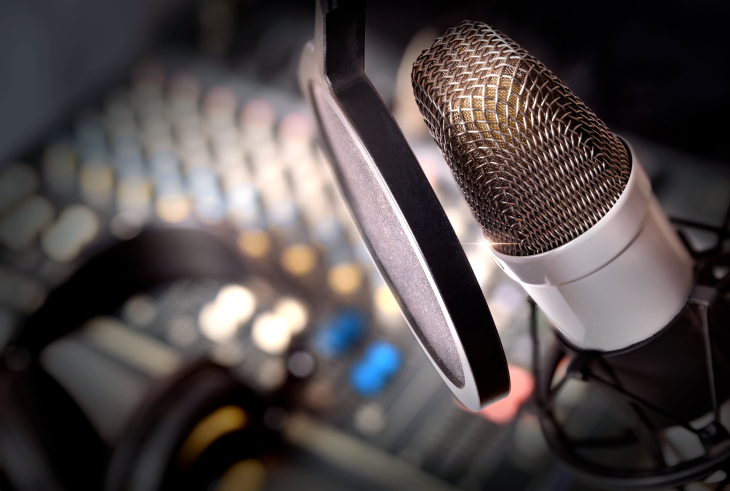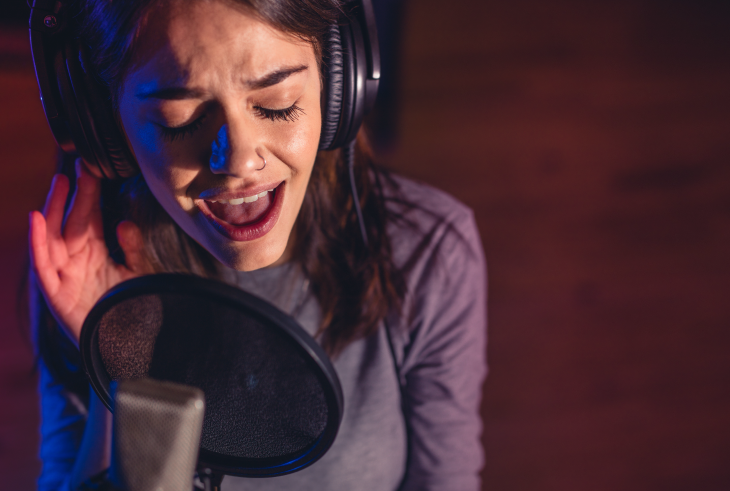Ep 10 Live Q&A – April 24, 2019 Question 7 – How do I shape my mouth when I sing vowels?
Mike Elson: (56:41)
How to shape my mouth when singing vowels? Also, types of vocal exercises?
Matt Edwards: (56:49)
I’m looking here to see if I have Altoids, and I don’t know that I do. So, is that a bag? No. All right. Usually on how to form your lips, what I do is I grab Altoids. You’re going to take those Altoids and you’re going to stick them in between your back molars. Since I don’t have Altoids, I’m just going to stick my fingers in through my cheeks into my molars.
Matt Edwards: (57:09)
Then you slowly bite down on those Altoids or on my fingers, and when you’re in this position, it requires you to form all vowels and consonants with your lips and jaw. It’s way more effective with Altoids, because trying to hold your cheeks in doesn’t feel the best. This comes from a guy named Arthur Lessac. Lessac, he talks about using wine corks. I sawed up a couple wine corks, it tasted terrible, and Altoids, I find at least they taste minty.
Matt Edwards: (57:38)
So you get them in there, and then you start going through the vowels that you’re having issues with. So, (singing). You’re starting to teach your body that it is only your tongue and your lips that are responsible for vowel formation, and your jaw needs to stay out of the way. Shades of gray on that, that is a starting place to keep your jaw out of it.
Matt Edwards: (58:04)
When you are going for vowels like oh and ooh, they require your lips to be forward. So I could go (singing), that’s not really an ooh vowel. I could try to make the ooh in the back of my throat, (singing), and I can, but did you hear how woofy it got? It got real fake. Instead, I need to shift the rounding to my lips. All of a sudden, my throat releases, everything comes out. We want to do those three back to back. (singing) All right. Your lips really make a difference.
Matt Edwards: (58:45)
Ooh, oh, you need those rounded and forward. As we go to things like aw, like aw, that’s a cute baby, they start to open up a little bit, and by the time we get to an ah vowel, the lips are more open. Then as we start to narrow back down into the closed vowels like e, we’re going to again start bringing the lips forward. But instead of rounding them forward, they’re starting to go a little bit more smiley forward.
Matt Edwards: (59:08)
So we would go from ah to aah, starting to tweak that way, to ih, to ay, to e. (singing) Now, if you’re a classical singer, you might narrow those lips in. But it depends on what you’re looking for. But start going through using those Altoids and experiment and find what happens with the vowel when you move your lips between a smiley position, a forward position, and a neutral position, and then play around with what happens when you think of the vowel being formed on the back of your tongue versus the vowel being formed on the front of your tongue. The voice science tells us that vowel clarity is primarily produced in the front of the of the hump of your tongue, but there are some pedagogies where people talk about forming the vowels in the back.
Matt Edwards: (59:54)
I’ve seen ways that people do that that I totally get where they’re coming from and it makes sense for classical singing, but it also can tie other people up. So experiment with that, and if you notice, wow, I’m getting tied up when I think about vowels in the back, that may not be for you. Try focusing instead on the front and see if maybe it’s a breakthrough [inaudible 01:00:10].
Matt Edwards: (01:00:11)
Then finally, using those Altoids, pick up a song you’re working on and sing through the song on the Altoids. It’s going to make you only use your lips and tongue. Watching in the mirror for all this work is really helpful because then it starts to raise your awareness of what you feel and what’s actually happening in your body. Then after you’ve gone through singing that song with the Altoids, take them out and see where you are at that point in time. Most of my clients find that once they take those Altoids out, their diction is very different, much clearer, and they have a greater awareness of the way that they articulate as well.
Mike Elson: (01:00:44)
Absolutely. For me, when I read this question, I was thinking it’d be great if we had a way to model the different vowels and the shapes of the tongue position and how we create the different vowels. But we don’t have that today for you. I think we do have some MRI videos, so I’m wondering, maybe we can drop in an MRI video [inaudible 01:01:08]?
Matt Edwards: (01:01:08)
Yeah, let’s drop in a link, because there’s actually a link … It’s by one of the California universities where they have a vowel chart, and if you click on the vowel, it brings you up a video of a person forming that vowel inside the MRI machine. So you can go through and look at every vowel and consonant in the English language pronounced by four different speakers so you can start learning exactly how the moving parts are supposed to move to form those sounds.
Mike Elson: (01:01:37)
Yeah. I was going to say, we’ll show you that. Then the other thing, you’re asking about the shape of the mouth. A lot of my training was more of the classical training, but still applicable to any type of singing, and I’ve always learned that the mouth, at least the lips, the part that you see of the mouth, is really the finishing shape. If we compare it to a horn, like a trumpet or something like that, it’s the bell of the horn. So you could sing the same note, the same volume, the same sound color, and just change the shape of the lips and maybe make a little more room with the jaw. So you’re just changing the finish of the sound as it’s released.
Mike Elson: (01:02:20)
With that, there’s a lot of different consonants that we can use, just so you can start to change the shape of the lips. B or a P or an F, so you’re doing different things with your lips that are then going to help you experiment with … Okay, so maybe you’re asking this because you’re singing a song with this specific vowel. We’ll give you a link. You can watch how the tongue … Excuse me … the tongue and the other parts of your vocal tract are shaping for that vowel. Then as it relates to the mouth or the finishing of that vowel, I would say there’s a few different exercises. Most of them involving … Just pick a simple scale, one, two, three, four, five. Do, re, mi, fa, sol … Whatever that scale is, and then sing the same vowel, but try different consonants.
Mike Elson: (01:03:21)
Singing (singing) and experiment with, okay, what is my mouth doing, and am I getting more sound or less sound with that? Obviously, working with a coach, and they can help guide you through that. But with yourself teaching here, learning, trying to figure out what to do next, I would say try different consonants with the vowel that you’re maybe having trouble with to figure out which consonants are starting to unlock, or you’re creating a different sensation that you weren’t able to get.
Matt Edwards: (01:03:54)
Yeah.
Mike Elson: (01:03:54)
Okay. That’s what we have on that. Let’s see. Anything else for today, Matt? Did you want to … I know you’ve got an important thing coming up this summer.
Matt Edwards: (01:04:05)
Oh, yeah. I’ve got a couple of important things I can tell you about. I tried to drop in that link, I’m not sure if it posted. You might want to check on your end.
Mike Elson: (01:04:12)
I think there’s a little delay, so we’ll find out in a second.
Matt Edwards: (01:04:14)
Yeah. Actually, if you are in the New York City area, you can stop by and see me this weekend at Columbia Teacher’s College. I’m doing a masterclass for New York City NATS. They tell me it’s the largest crowd they’ve ever had that they can remember for one of their masterclass events, which is pretty exciting. When I checked earlier, I think they had 16-18 spots left. Great thing is, it’s free, so it’ll be three hours of me teaching. You can come in, check it out, and I’ll be there to answer questions and whatnot. But I think if you’re in that area and you’ve been watching this show and you want to see how this stuff is actually applied in real time, it’s a great opportunity.
Matt Edwards: (01:04:53)
Then I have my CCM Vocal Pedagogy workshop coming up, and the CCM Vocal Pedagogy Institute is held at Shenandoah Conservatory in Winchester, Virginia. We’re outside of Washington, DC. I have a great faculty full of speech language pathologists, performers, I have a colleague who teaches at Berklee who’s on their popular voice faculty over there. I’ve got choral music educators who specialize in working with young singers. I have teachers who are specialists in helping people cross over from classical to commercial styles, and I have singer songwriters who are there to help people find their own unique voice and to tell their story authentically.
Matt Edwards: (01:05:32)
It’s nine days, and the first three days, we dive into the science behind respiration and tonation, how registration works, how to balance registration in a singer. A lot of the stuff that Mike and I have been talking about. In the second three days, we start talking about what happens above the vocal cords. We use real MRI imaging so that you can actually watch what is happening when a tongue retracts, and you can learn to hear that sound so that when you listen to a recording and you hear an er, you’ll know that that’s tongue retraction, and you’ll have a visual inside of your mind from watching those MRI videos.
Matt Edwards: (01:06:07)
Then we give you a set of tools to directly address that tongue issue to get quick results. Quick results, because it’s a specific exercise for this specific issue. These aren’t cheats. This is just going, your tongue is in the back of your mouth. Let’s get it out of the back of your mouth. Let’s use some motor learning theory to help you build up an exercise regimen that permanently fixes this, and we know from exercise physiology research that most neurological adaptations happen [inaudible 01:06:36].
Matt Edwards: (01:06:37)
So if you’re focusing on just your tongue, we should be able to get that out of the way in four to six weeks. Then in the last three days, we really dive into what it’s like to sing all these various styles. What’s different between country and rock and roll and jazz? There’s a lot of group singing involved in that as well. We talk about the African roots of these styles and give credit where credit’s due, because if it wasn’t for African music from that continent, we wouldn’t have pop today in the United States.
Matt Edwards: (01:07:07)
The best part of it is on top of not only the science and the artistry, it’s a community. Every year, we have around 100 to 150 people come. Registration this year is ahead of where it’s been in the last five years we have on record, so we’re expecting a great crowd this summer. There’s a hotel across the street, we rent out the swimming pool every night, so people can go hang around the swimming pool, bring wine, cheese, snacks, and talk and network. We have half hour breaks with coffee and snacks so people can network with each other, get to know each other. We have of course dinner and lunch breaks. People make lifelong friends out of this, and make great connections, and it’s really awesome when we watch an attendee who connected with another attendee end up working at that person’s university, because they both ended up doing the training together. They found that they like each other and they liked each other’s approach, and all of a sudden, they form their own team at a different university or a private studio.
Matt Edwards: (01:08:06)
So it’s truly a magical place. I look forward to it every summer. I always say there’s no egos at the CCM Institute. This is not about the faculty, this is about the participants. We’re there to help the participants unlock whatever it is they’re seeking about their own voice and in their students’ voice, and we do everything we can to make sure that they leave with the tool set and a game plan to start taking their teaching or singing to the next level.
Mike Elson: (01:08:32)
Fantastic. Hey, guys. Thanks everyone for tuning in. We enjoy doing these broadcasts for you. If you have more questions, if you’re a teacher, if you’re a student, you’re out there seeking, you found us on the blog or the internet, however you heard about us, we do sometimes run these to pull people in as a little ad on Facebook, however that works. So come on in, drop your question in below, we’ll continue to … Like we said, we try to provide you with solutions, some education. Hopefully this has been entertaining, and you guys, thanks. We’ve still got some people that have stuck around for the whole thing, so thank you.
Mike Elson: (01:09:11)
Also, just going to let you guys know, we have our flagship software that we’ve been building for a while. I was going to say well over a year, right? The early beta was started two years ago. I personally have met with hundreds of teachers now to find out, what are you doing to teach online? I pretty much have heard every different way teachers are teaching online, and like Matt said, you know what? When I started meeting the teachers, I thought everyone was going to want to be interested. Then now that I understand it’s only 33% that are probably interested, that are really interested, 33% that are maybe kind of interested, and 33% that don’t even give a … they don’t care. I’m over that.
Mike Elson: (01:09:57)
But what I can tell you is we’ve amassed so many great ideas, and we’ve built a platform for online singing lessons, and we have our first patent that we got last year awarded, and we have our second patent underway. So we’ve got some really cool patented ideas on how you can do these online singing lessons. We’re starting to let some teachers in, test it out, and in fact, this is a shout out for students. Students, listen up. If you want to get a free lesson, we’re taking a few students in, because we’re looking for some other people. We want to make sure it’s totally dialed in before we get everyone on board, so just jump on in, join … message us through the site, and we’ll let you on in.
Mike Elson: (01:10:42)
Not really a pitch, just letting you know some fun stuff is coming, everyone. So thanks for staying, tuning into our show, and drop us any questions you have, and thanks, everyone. Have a great week.
Matt Edwards: (01:10:54)
See you next week.
Mike Elson: (01:10:57)
Thanks, bye bye.
Matt Edwards: (01:10:58)
Bye.
about the author
Mike ElsonMike loves to sing and make magic happen with computers and music. After trying lots of ways that didn't work to find his head voice, his voice ended up broken and his concepts mixed up. Before there was Google, he rebuilt his technique from square one with Dr. Joel Ewing, providing him plenty of humility and loads of first-hand empirical knowledge about the inner workings of the voice. Mike strongly believes that "everyone should be trained as a tenor," because of the additional skills required in balancing registration for this specific voice type. He has enjoyed singing in Mrs. Kim Barclay Ritzer's award-winning GVHS choir in Las Vegas, Nevada and with Dr. Dhening's internationally acclaimed USC Chamber Choir in Los Angeles, CA. Mike brings his passion for singing along with his pedigree to bring the voice training industry a new platform to make online voice lessons more successful, help choirs raise funds, and grow better singers. VoiceLessons.com is a way to pay it forward to a new generation of singers who are looking to start their training or take their voices to the next level by searching for options online. Welcome, and enjoy!
RECENT ARTICLES
RECENT IN KNOWLEDGE
Recent Topics
- Beginning Voice Lessons (1)
- Breathing Techniques (1)
- Confidence (1)
- Experienced Teacher (1)
- Kids Singing Lessons (1)
- Musical Career (1)
- Practice (1)
- Private Lessons (1)
- Professional Singer (2)
- Sing (1)
- Singing Teachers (2)
- Style (1)
- Teach Online (1)
- Vocal Exercises (1)
- Vocal Health (1)
- Vocal Music (1)
- Vocal Pitch (3)
- Vocal Range (4)
- Voice Coach (1)
- Voice Exercises (2)
- Voice Training (4)
- Young Vocalist (1)
Categories
- Basic Skills (7)
- Beginners (8)
- Career (2)
- CCM (1)
- Contemporary Commercial Music (1)
- Crossing Over (1)
- Exercises (2)
- Online Lessons (3)
- Online Voice Lessons (1)
- Songs (2)
- Students (6)
- Tips (4)
- Vocal Coaches (1)
- Voice Teachers (2)
- Warmups (2)
Testimonials




-
Ep 10 Live Q&A - April 24, 2019 Question 7 - How do I shape my mouth when I sing vowels?
-
Ep 10 Live Q&A - April 24, 2019 Question 1 - How do you control a vibrato that is too fast?
-
Ep 4 Live Q&A - March 13, 2019 - How do you know your voice is damaged?
-
Ep 3 Live Q&A - March 6 2019 - How much breath do you need to support a good belt?
-
No Post Found!!







